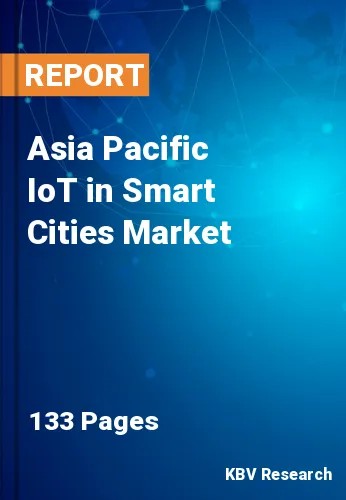The Asia Pacific IoT in Smart Cities Market would witness market growth of 20.8% CAGR during the forecast period (2021-2027).
Smart city initiatives around the world are being enabled by new Internet of Things (IoT) applications. It enables remote monitoring, management, and control of devices, and extracts valuable insights and actionable data from huge quantities of real-time data. A high degree of information technology integration and a broad application of information resources are two of the most important characteristics of a smart city. Smart technology, smart industry, smart services, smart management, and smart life should all be included in the urban development of a smart city.
The smart city is an emerging market and a crucial aspect of future infrastructure, similar to the concept of a smart home environment. The importance of IoT technology is amplified in a smart city since it aspires to use energy and electricity efficiently, thereby offering a convenient and economically sound infrastructure for society's well-being. As a result, once the general infrastructure of a smart city has been established, many services that need the use of various types of data acquired in daily life can be given. This means that numerous IoT-enabled services in a smart city can help inhabitants live in a more sustainable and better environment.
The desire for smart building and space solutions in densely populated areas would drive the demand for disruptive technologies like IoT in the region. China, South Korea, Japan, Singapore, and India, all of which are quickly developing economies, are heavily investing in internet of things solutions. Moreover, the regulatory bodies of these countries are putting a lot of effort into establishing smart city projects to improve security and quality of life. For example, the Chinese municipal government of Xiangtan received a USD 200 million loan from the Asian Development Bank (ADB) for its smart city initiative in October 2020. China's Ministry of Housing and Urban-Rural Development (MOHURD) released the first list of national pilot Smart Cities in 2013. There were 326 smart city initiatives in the country by 2015.
In 2020, the Seoul Metropolitan Government, in collaboration with the World Bank, organized Korea Innovation Week to showcase Korea's technological advancements. A total of 40 government representatives from 12 nations learned about the city's smart city growth and transformation.
The China market dominated the Asia Pacific IoT in Smart Cities Market by Country 2020, and would continue to be a dominant market till 2027; thereby, achieving a market value of $28.4 billion by 2027. The Japan market is anticipated to grow at a CAGR of 20% during (2021 - 2027). Additionally, The India market would display a CAGR of 21.5% during (2021 - 2027).
Based on Component, the market is segmented into Solution and Services. Based on Solution Type, the market is segmented into Remote Monitoring, Data Management, Security, Real-time Location System, Reporting & Analytics, and Network Management. Based on Services type, the market is segmented into Professional Services and Managed Services. Based on Application, the market is segmented into Smart Citizen Services, Smart Building, Smart Transportation, and Smart Utilities. Based on countries, the market is segmented into China, Japan, India, South Korea, Singapore, Malaysia, and Rest of Asia Pacific.
Free Valuable Insights: The Worldwide IoT in Smart Cities Market is Projected to reach USD 347.6 Billion by 2027, at a CAGR of 18.8%
The market research report covers the analysis of key stake holders of the market. Key companies profiled in the report include IBM Corporation, Schneider Electric SE, Siemens AG, Microsoft Corporation, Intel Corporation, Hitachi, Ltd., Tech Mahindra Limited, Huawei Technologies Co., Ltd. (Huawei Investment & Holding Co., Ltd.), Robert Bosch GmbH, and Honeywell International, Inc.
By Component
By Application
By Country
Our team of dedicated experts can provide you with attractive expansion opportunities for your business.

